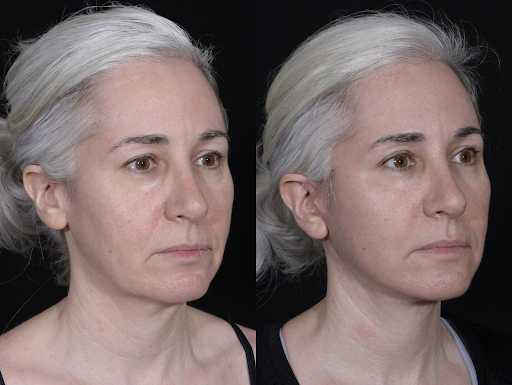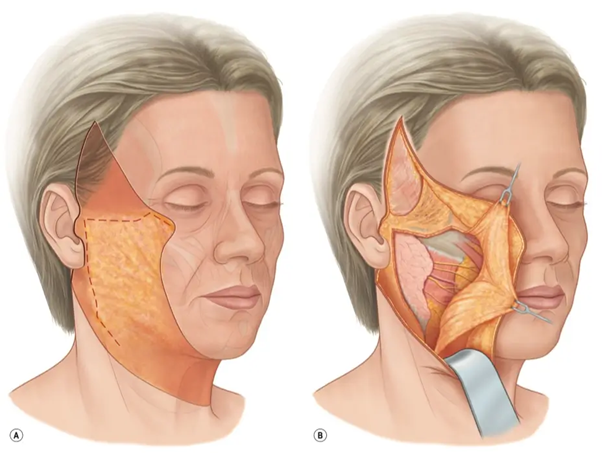While skincare and non-invasive treatments can help delay these changes, there comes a time when surgical intervention provides the most effective and lasting results. Two of the most advanced facelift techniques available today are the SMAS facelift and the deep plane facelift. Both methods aim to rejuvenate the face by tightening underlying structures and restoring youthful contours, yet they differ in their depth, precision, and overall results. Understanding how these techniques work and which one best suits your facial anatomy is essential before making your decision.
Over time, the skin loses elasticity, facial fat diminishes, and gravity begins to pull soft tissues downward
What is a SMAS Facelift?
The SMAS facelift, short for Superficial Musculoaponeurotic System facelift, has been a gold standard in facial rejuvenation for decades. The SMAS layer is a thin sheet of connective tissue that lies between the skin and deeper facial muscles. It plays a key role in facial movement and expression, and it is the foundation that surgeons manipulate to lift and tighten sagging skin effectively.
During a SMAS facelift, the surgeon makes incisions typically around the ears and hairline, then carefully lifts and repositions the SMAS layer. The overlying skin is redraped smoothly over the new structure, removing excess tissue and minimizing visible sagging. This method primarily addresses the lower two-thirds of the face, including the jawline and neck, giving patients a more defined, youthful profile.
SMAS facelifts are renowned for their balanced results—a natural lift without the “overdone” appearance often associated with older facelift styles. The recovery period is generally moderate, and results can last from 8 to 10 years depending on lifestyle and skin condition.
What is a Deep Plane Facelift?
The deep plane facelift represents a more advanced evolution in facial surgery. Instead of stopping at the SMAS layer, this method goes deeper, releasing the facial ligaments that tether the muscles and lifting the skin and muscles as a single unit.
By working beneath the SMAS layer, surgeons can reposition not only surface tissues but also deeper facial fat pads that contribute to volume loss and sagging. The result is a more comprehensive rejuvenation, one that restores youthful fullness in the midface, softens nasolabial folds, and redefines the jawline without creating tension on the skin’s surface.
The deep plane facelift is often considered the “gold standard” among top surgeons in the United States, as it provides longer-lasting, more natural-looking results
Key differences between SMAS and Deep Plane Facelift
While both techniques aim to reverse the visible signs of aging, they differ in depth, approach, and results. The SMAS facelift targets the superficial layer for structural tightening, whereas the deep plane facelift goes below it to mobilize deeper tissues.
The deep plane approach offers more dramatic midface rejuvenation, especially for patients with sagging cheeks and pronounced folds around the mouth. It can restore youthful contours without the skin tension or pulled look that sometimes appears in more traditional facelifts.
On the other hand, the SMAS facelift remains an excellent choice for those seeking moderate correction of jowls and neck laxity, especially if they are not yet ready for a more extensive procedure. It is typically less invasive, with shorter operating times and slightly quicker recovery.
Choosing the right method for You
Deciding between a deep plane and SMAS facelift depends on multiple factors—your facial anatomy, degree of skin laxity, age, health condition, and desired outcome. A personalized consultation with a qualified facial surgeon is the most reliable way to determine which technique aligns with your goals.
If your main concern is lower face sagging, jowls, or mild-to-moderate aging, a SMAS facelift may be ideal. It effectively tightens the skin and underlying tissue to refine your jawline and neck with minimal downtime.
However, if you experience more advanced aging, hollow cheeks, or deep nasolabial folds, the deep plane facelift offers a more transformative result. By repositioning the deeper structures, it restores both lift and volume for a youthful, naturally refreshed appearance.
Facial aging is a natural process that affects everyone differently.
Safety and Recovery considerations
Both facelift methods are considered safe when performed by experienced, board-certified plastic surgeons in accredited facilities. The main difference lies in the depth of dissection and the recovery experience.
The SMAS facelift typically involves mild swelling and bruising that subside within two weeks, with patients often returning to social activities after three weeks. The deep plane facelift may require a slightly longer recovery due to its deeper adjustments, but most patients resume normal routines within four to six weeks.
Pain and discomfort are generally mild and manageable with prescribed medication. Post-surgery care, including head elevation, gentle cleansing, and follow-up visits, plays a crucial role in ensuring smooth healing and optimal results.
Modern techniques, including refined anesthesia and micro-suturing, further enhance patient safety and minimize visible scarring.
Longevity and natural results
One of the biggest advantages of both facelift techniques is their longevity. SMAS facelifts can last up to a decade, while deep plane facelifts often deliver results that endure for 12 to 15 years or more.
The naturalness of the results depends greatly on the surgeon’s skill and artistic understanding of facial anatomy. A well-performed facelift should not look “tight” or artificial. Instead, it should restore harmony, youthfulness, and vitality while preserving each patient’s unique facial expression.
Deep plane facelifts, in particular, stand out for their ability to rejuvenate without tension. Because the lift occurs deeper in the tissue plane, the skin is draped naturally, producing a soft and authentic appearance that moves freely with expression.

A carefully executed facelift can restore a positive self-image and contribute to improved quality of life.
Why expertise matters about Deep Plane or SMAS Facelift ?
The sophistication of techniques like the deep plane facelift means they require an exceptionally skilled hand. Only surgeons with advanced anatomical understanding and precise technique can perform these procedures safely and effectively. Choosing a reputable clinic that prioritizes safety, artistry, and patient care ensures the best outcome possible.
Patients should always verify that their surgeon is board-certified, the facility is licensed, and the team is trained in facial aesthetic surgery. Transparent communication and a tailored surgical plan are vital to achieving natural, satisfying results.
Dr. Harvard – Your best beauty surgery clinic for Deep Plane or SMAS Facelift
At Dr. Harvard, we understand that facial rejuvenation is both a science and an art. Our surgeons are internationally trained and certified, with extensive experience in advanced facelift techniques including SMAS and deep plane procedures.
We focus on delivering natural, long-lasting results tailored to each patient’s facial structure. Every step from consultation and pre-operative planning to recovery and aftercare, is guided by a commitment to safety, precision, and aesthetics.
Our clinic is equipped with state-of-the-art technology, sterile surgical suites, and personalized recovery programs designed for comfort and optimal healing. With our signature approach, you will not only look younger but also feel more confident, refreshed, and authentically yourself.
If you are considering a facelift, let Dr. Harvard be your trusted partner in achieving timeless beauty. Schedule your consultation today to discover which method is right for you, and begin your journey toward a more youthful, radiant version of yourself.















